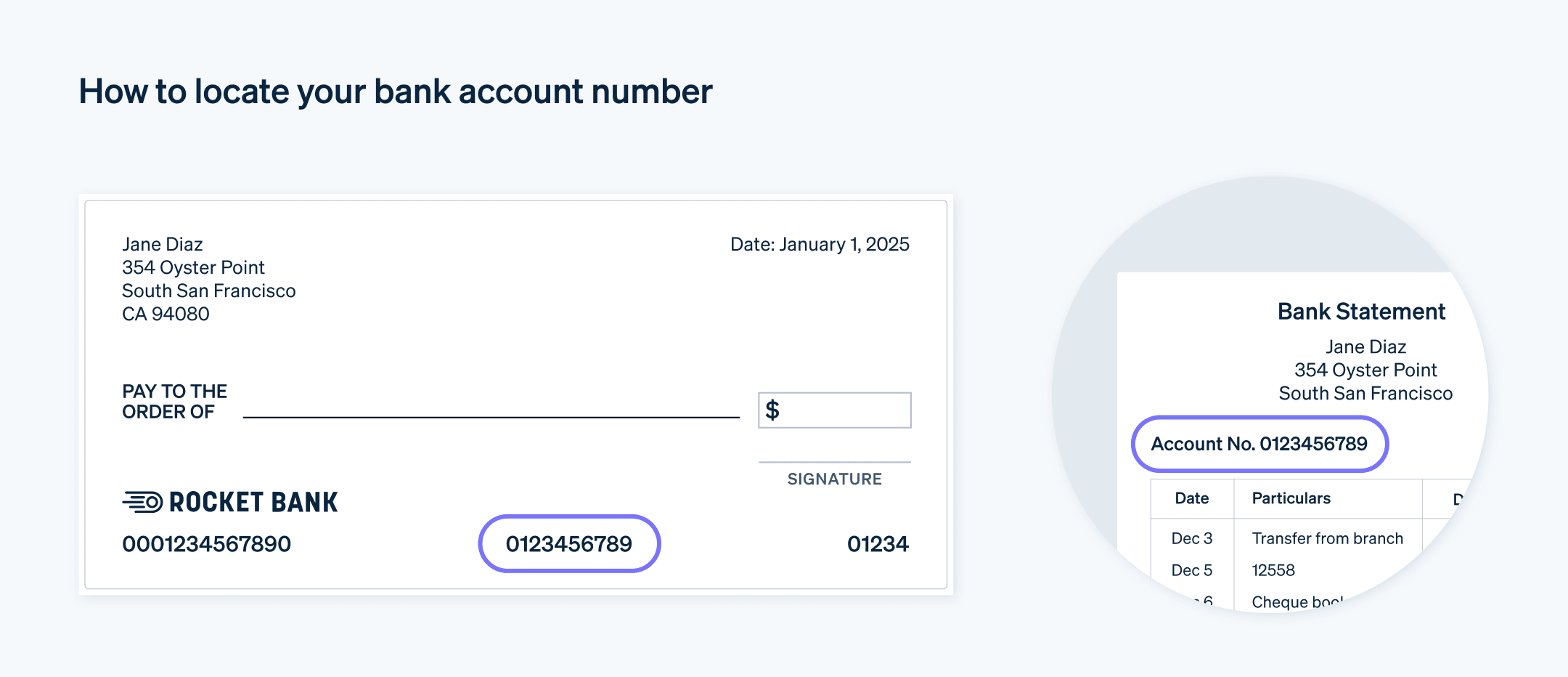Um número de conta bancária é um identificador exclusivo atribuído a uma conta bancária específica. Os números de conta podem variar em tamanho e formato, dependendo da instituição ou serviço. Para transações financeiras, o número da sua conta é como sua impressão digital, identificando quem você é para transações e atualizações de conta.
Globalmente, 76% dos adultos tinham uma conta em um banco ou instituição regulamentada em 2021, de acordo com a pesquisa mais recente do Banco Mundial. Este guia aborda o que as empresas precisam saber sobre os números de conta e como eles funcionam em contextos financeiros.
O que há neste artigo?
- Como os números de conta são usados?
- Como encontrar o número da sua conta
- Diferença entre routing number e número da conta
Como os números de conta são usados?
Os números de contas bancárias identificam contas individuais dentro de um banco ou instituição financeira. Geralmente com entre 8 e 12 dígitos, eles são usados em transações financeiras para garantir que fundos sejam adicionados ou removidos da conta apropriada. Os números de conta são usados para facilitar depósitos, saques, transferências eletrônicas de fundos (EFTs), depósitos diretos, wire transfers e cobrança automática. Os números de conta também são usados para gerenciar contas, permitindo que clientes e funcionários do banco acessem informações de conta, saldos e histórico de transações.
Como encontrar o número da sua conta

Extratos bancários: tanto o extrato bancário em papel quanto o eletrônico devem incluir o número da conta bancária. Procure uma seção chamada "Detalhes da conta" ou na parte superior do documento onde indicam os dados do titular da conta.
Cheques: se você tiver um talão de cheques, o número da conta normalmente é impresso na parte inferior de cada cheque. É o segundo conjunto de números entre o routing number e o número do cheque.
Online banking: os números das contas são listados em contas bancárias online, acessíveis via site ou aplicativo móvel. Normalmente, eles são exibidos em "Detalhes da conta", "Resumo da conta" ou "Configurações do perfil".
Cartões bancários: em alguns casos, o número da conta pode ser impresso em cartões de débito emitidos pelo seu banco. No entanto, os cartões de débito costumam ter um número de cartão diferente do número da conta.
Agência bancária ou atendimento ao cliente: se você não conseguir encontrar o número da sua conta usando os métodos listados acima, vá a uma agência bancária local ou fale com o atendimento ao cliente. Eles podem verificar sua identidade e informar o número da sua conta.
Diferença entre routing number e número da conta
Routing number
O routing number é um código de nove dígitos usado para identificar uma instituição financeira ou agência bancária específica nos Estados Unidos. Também é conhecido como routing number da American Bankers Association (ABA).
Os routing numbers informam o banco e a agência envolvidos em transações financeiras, como depósitos diretos, wire transfers, cheques e transferências da Automated Clearing House (ACH). Um único banco pode ter vários routing numbers, dependendo de seu tamanho, localização e serviços específicos.
Número da conta
Um número de conta é um identificador exclusivo atribuído a uma conta específica dentro de uma instituição financeira. Ele distingue uma conta de outra dentro do mesmo banco ou agência. Os números de conta variam em tamanho e formato, dependendo do banco ou instituição.
Os números de conta são usados para rastrear e gerenciar contas individuais. Em transações financeiras, como transferências de fundos, os números de conta identificam a conta específica para a qual ou da qual os fundos devem ser transferidos. Enquanto o routing number identifica a instituição financeira, o número da conta identifica a conta específica dentro dessa instituição. Muitas vezes, as transações financeiras exigem os dois números para transferir fundos corretamente.
O conteúdo deste artigo é apenas para fins gerais de informação e educação e não deve ser interpretado como aconselhamento jurídico ou tributário. A Stripe não garante a exatidão, integridade, adequação ou atualidade das informações contidas no artigo. Você deve procurar a ajuda de um advogado competente ou contador licenciado para atuar em sua jurisdição para aconselhamento sobre sua situação particular.